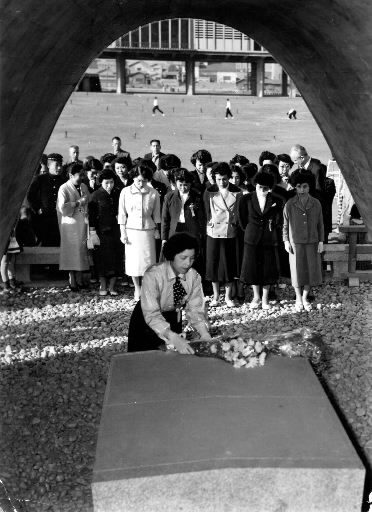Hiroshima Girls, Part 3: Half a Century After the Bombing [4]
Jul. 3, 2010
Fashion designer remains reticent until her death
by Masami Nishimoto, Staff Writer
This feature series on the "Hiroshima Girls," also known as "Hiroshima Maidens," is a close look at a number of Japanese women who were impacted by the atomic bombing of Hiroshima. The series was originally published in 1996.
One of the "Hiroshima Girls," a fashion designer, passed away in April of last year. She was 69.
When she was hospitalized at Hiroshima City Hospital, the Chugoku Shimbun sent her a letter which asked about her A-bomb experience and memories related to the medical treatment in the United States, in covering the story of the 50th anniversary of the atomic bombing. A reply was returned from her sickbed.
"Out of everything, the experience of having lived happily with an American family, as a family member, is my best memory," she wrote. "I came to feel strongly that my keloid scars were not something to be ashamed of and that I wanted to turn my disadvantages into advantages." The letter was written in a scrupulous hand that revealed an aspect of her character.
The woman, who wishes to withhold her name, experienced the atomic blast in Naka Ward, about one kilometer from the hypocenter, while helping to dismantle houses to create a fire lane. She was exposed to the bomb's thermal rays, which seared scars on her neck and shoulders. Soon, she became a member of the "Zion Group," formed by single A-bomb women who would gather at Hiroshima Nagarekawa Church. The group, named after a verse from a hymn, is more generally known by the name "Group of Hiroshima Maidens."
In 1952, she was one of nine hibakusha who were seen by doctors at Tokyo University. This effort was led by the Rev. Kiyoshi Tanimoto, who proposed treating A-bomb survivors (hibakusha) in the United States. Rev. Tanimoto died in 1986 at the age of 77. Their visit to the Tokyo University hospital heightened public interest in relief measures for hibakusha. Partly because she was the oldest member of the group, the designer often appeared before the mass media as the group's representative.
She also contributed written material to a collection of writing published by the group members. She was 27 years old at the time. She described the days after the bombing as follows: "My life was occupied solely by death and despair." She concluded with a Japanese poem of 31 syllables: "Father, please give your helping hand to me on the cross, for I have no one to turn to."
Most of all, she said, the love she felt from the people she encountered during her time of treatment in the United States made her very happy. Speaking from her hospital bed, too, when she recounted her days in the United States, where she began to move along a path to independence, she focused on the dedication of the Japanese and American women who served as mother figures.
With the support of Quaker families who opened their homes to the women as host families, she remained in the United States for over two and a half years beyond her treatment. She studied at one of the top design schools in New York and even went to Europe to continue her studies. After returning to Japan, she held a fashion show at the Imperial Hotel and, in Tokyo, opened a haute couture store bearing her name.
However, she hesitated to describe her life after the atomic bombing openly. "I want to hand down my experience, but I've never talked about it, not even to my family. I'm afraid that I couldn't help but complain." Two months after revealing these mixed feelings, she passed away.
"The anxiety she felt about the recurrence of cancer may have made her hesitate to talk about herself." Her brother, who is six years younger and lives in a Hiroshima suburb, imagined the thoughts that passed through the mind of his late older sister.
He said that she returned to Hiroshima, past the age of 40, when she was diagnosed with rectal cancer. "While going to the hospital for treatment, she grew fond of alcohol and became withdrawn," he explained. "In particular, she didn't want to talk about the atomic bombing." Her feelings for the years after the bombing are not clear even to her family now.
Quaker support for the "Hiroshima Girls" also aimed to help them stand on their own feet after they finished treatment and returned to Japan. For various reasons, the effort was unsuccessful. Still, the designer displayed her American-trained skill in a room of her apartment and took on the task of providing instruction to foster fashion designers and cloth-cutters, after she came back to Hiroshima. She lived for her career and worked all her life.
The "Hiroshima Girls" are still also referred to as "Hiroshima Maidens." Regarding this label, the designer, in spite of her poor health, wrote to convey her feelings on the subject.
"Like all of you, I'm a human being. As I have my own persona, I don't want people to call me that. The older I get, the more strongly I feel that way."
Of the 25 women who called public attention to the reality of the atomic bombing at home and abroad, five have already passed away.
(Originally published on July 30, 1996)








